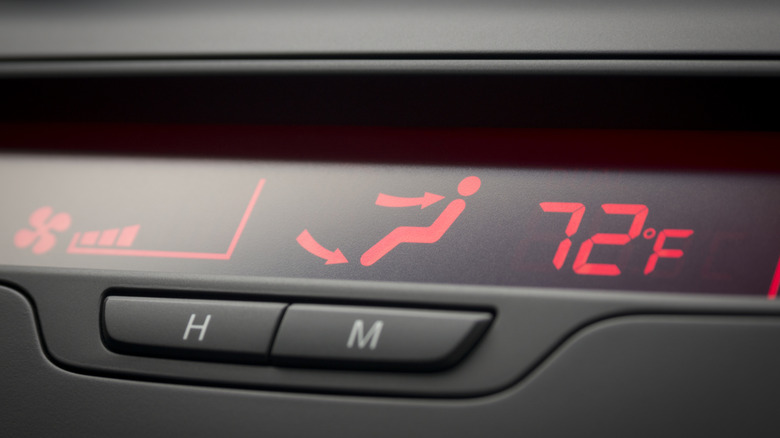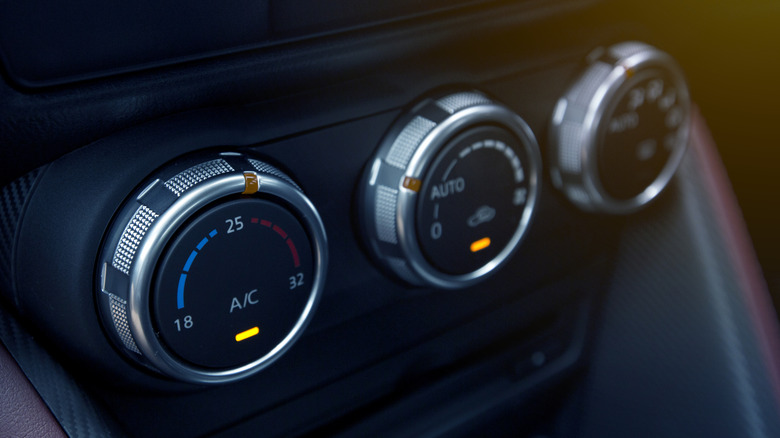What Does HVAC Stand For And What Is Its Purpose In A Car?
The earliest record of an air-conditioned car was in 1933 when a New York-based installer became the first to retrofit an HVAC, which stands for Heating, Ventilation, & Air Conditioning, system to limousines and luxury vehicles. However, the Packard Motor Company was the first automaker to offer an HVAC system from the factory in 1940. Unlike the dashboard-mounted HVAC controls we've grown accustomed to in modern cars, the Packard's air-conditioning system is trunk-mounted, requiring manual fitment of the drive belt to the compressor to turn it on or off. It was a $274 (about $5,000 today, adjusted for inflation) option, which was a lot of money in the Depression Era, and the A/C components took up more than half of the trunk space.
Things changed in 1954 when Pontiac and the Nash Motor Company became the first to relocate the HVAC system to the dashboard, combining the heating and air conditioning into a single control unit. HVAC became a vital element of the motoring experience, and it became standard for half of new cars sold by 1969. HVAC's "heating" part routes engine heat inside the cabin to raise the temperature in chilly weather. On the other hand, the "air conditioning" bit cools the cabin air by manipulating Freon or refrigerant and turning it into liquid or gas.
How does automotive HVAC work?
The HVAC system in cars is no different from your home's window-type or split-type air-conditioner. It's just that the parts are different or smaller and optimized for automotive applications. The heating part of an HVAC is quite simple and ingenious at the same time. Turning on the heater in your car enables hot coolant from the radiator to flow into the heater core inside the dashboard. Meanwhile, the fan blows air to the heater core and into the A/C vents to effectively warm the cabin.
The air conditioning part of the HVAC is a bit complicated. The system includes a compressor, condenser, receiver-dryer, expansion valve, evaporator, blower, thermostat, and freon/refrigerant to function well. Of all those parts, only the evaporator, expansion valve, and blower are behind the dash. The others are in the engine bay.
The process begins in the compressor, turning low-pressure refrigerant gas into high-pressure. The gas flows inside the condenser (usually in the radiator's front) as it cools and turns to liquid. It then goes into the receiver/dryer to "clean" the refrigerant and eliminate moisture, contaminants, and impurities. Next, it moves through the expansion valve, which reduces the pressure and allows the refrigerant to enter the evaporator as a cold mixture.
Inside the evaporator, the refrigerant absorbs heat from the cabin air, evaporates into gas, and cools the evaporator. The blower fan then circulates this cool air through the cabin vents. Finally, the low-pressure refrigerant gas returns to the compressor, and the cycle repeats.
Does HVAC affect my car's fuel economy?
Yes, car air conditioning can reduce fuel economy by up to 25% during the hottest summer months. Meanwhile, city driving during the winter can reduce your car's gas mileage by 15% or up to 24% for shorter trips. Using the heater similarly affects fuel economy when cold since it requires a warm engine (or extended idling periods) for the heater to work.
However, you can save a bit of gas if your car's HVAC system is in tip-top shape. Although the service intervals would depend on many factors (the make and model of your vehicle, usage scenarios, etc.), we highly advise bringing your car's HVAC for inspection, cleaning, or servicing at least once a year.
The least you can do is replace the cabin filter every 15,000 to 25,000 miles to free the cabin air of air pollutants and contaminants. Meanwhile, if you notice strange smells emanating from the A/C vents or if it persistently blows hot air instead of cold air, the HVAC may require servicing or refrigerant recharging, depending on the scenario.


